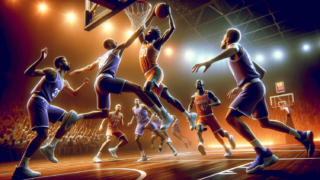
How to Improve Your Basketball Off-Ball Movement?
Written by: Basketball Universe
Last updated:

As any seasoned basketball aficionado will tell you, being a great player isn’t just about nailing those three-pointers or executing stunning dunks. A large part of the game relies on a skill that’s often overlooked yet immensely valuable: off-ball movement. In this informative and lively blog post, we’ll delve into the intricacies of this essential art, providing you with a comprehensive guide on how to elevate your basketball prowess to new heights. So, lace up your sneakers and get ready to outsmart your opponents, as we learn to optimize our off-ball movement and transform into a true basketball maestro.
How to Improve Your Basketball Off-Ball Movement?
To improve your basketball off-ball movement, focus on these key aspects: reading the game and anticipating plays, maintaining proper spacing from your teammates, utilizing different types of cuts (e.g., V-cuts, L-cuts, and backdoor cuts), setting effective screens, and mastering the art of losing your defender. Additionally, don’t forget to practice consistently and continuously increase your basketball IQ by watching accomplished players and analyzing their off-ball tactics.
Mastering the Art of Reading the Game
The first step to improving your off-ball movement is learning how to read the game and anticipating plays. Developing a higher basketball IQ will help you make better decisions on where to move without the ball. Here are some ways you can enhance your game sense and intuition:
- Watch and analyze basketball games: Study accomplished players, paying special attention to their off-ball movements and decision-making.
- Play frequently: The more you play, the more you’ll understand the game’s nuances and be able to anticipate the next move.
- Stay focused during practice: Use practice sessions to hone your mental skills and increase your awareness on the court.
Anticipating Your Opponent’s Moves
By carefully observing your opponents’ actions and tendencies, you can guess their next move and position yourself for an advantageous off-ball movement. Noticing patterns and anticipating the play will help you stay one step ahead of your competitors, allowing you to make quick, smart decisions on the court.
Spacing Fundamentals
Proper spacing is a crucial aspect of off-ball movement. Maintaining an appropriate distance from your teammates creates better scoring opportunities, opens up passing lanes, and reduces the chances of turnovers. Consider the following tips:
- Avoid overcrowding one area of the court. Clustering too close together makes it easier for defenders to cover your team and disrupt your offense.
- Stay beyond the arc when playing on the perimeter, but be ready to move inside when necessary.
- Remember the concept of “triple threat” and keep defenders guessing whether you’ll pass, shoot, or dribble.
Applying Spacing Principles
By applying smart spacing principles, you can strategically position yourself on the court and maximize your effectiveness as an off-ball player. For instance, when the ball-handler drives towards the basket, you may choose to move closer to the three-point line, creating an open passing lane and an easy scoring opportunity.
Master the Different Types of Cuts
As an off-ball player, understanding and executing various cuts is essential. Cuts allow you to lose your defender and create easy scoring chances. Let’s discuss some common cutting techniques in basketball:
V-Cuts
A V-cut enables you to create separation from your defender and receive open passes. To perform a V-cut, move towards the basket, plant your foot, then quickly change direction and burst towards the perimeter. This sudden change of speed and direction often catches defenders off guard, providing an open passing lane and potential scoring opportunity.
L-Cuts
Similar to V-cuts, L-cuts involve a change of direction to shake off defenders. Start by standing on the wing, then make a hard, straight cut towards the baseline. Once you reach the baseline, change direction, sprinting back towards the perimeter. This maneuver can create space for a catch-and-shoot, or open up passing lanes for your teammates.
Backdoor Cuts
Backdoor cuts are perfect for exploiting overzealous defenders. Start by moving towards the perimeter as if receiving a pass, then quickly cut to the basket behind your defender’s back. If the pass is well-timed, a backdoor cut can result in an easy layup or a wide-open shot.
Set Effective Screens
Setting solid screens for your teammates is a crucial part of off-ball movement. When executed properly, screens free up space for the ball-handler, create open shots, and disrupt the opposing team’s defensive plans.
Pick and Roll
The pick-and-roll is a classic basketball move that requires good off-ball movement and teamwork. As the screener, position yourself between the ball-handler’s defender and the ball-handler. Stand firm with your feet shoulder-width apart and your elbows bent at your sides to avoid offensive fouls. After setting the screen, roll to the basket, providing a passing lane for the ball-handler and an opportunity for an easy score.
Pick and Pop
The pick-and-pop is another popular screening technique. It involves setting a screen and then moving to an open position on the floor after the screen, rather than rolling to the basket. After setting the screen, you’ll “pop” to an open spot, usually along the perimeter, where you can catch the ball and take an uncontested shot.
Mastering the Art of Losing Your Defender
In order to get open and create scoring opportunities, you’ll need to learn how to lose your defender. Try incorporating these effective techniques into your off-ball movement repertoire:
- Change of pace: Vary your speed to keep your defender guessing, then burst into a sprint when they least expect it.
- Change of direction: Use cuts and quick pivots to shake off your defender and create space.
- Body positioning: Maintain control of your body and use it to shield the ball from the defender, preserving a passing lane for your teammate.
- Communication: Talk to your teammates on the court, coordinating your off-ball movements, and setting screens for each other.
Additional Tips and Tricks
To take your off-ball movement to the next level, here are some extra pointers to keep in mind:
- Stay in motion: Constantly move around the court and avoid standing still, making it harder for your defender to keep up with you.
- Keep your head up:Always be aware of what’s happening on the court, allowing you to better anticipate plays and position yourself effectively.
- Visualize success: Off-ball movement requires quick thinking, so rehearsing your movements in your mind can help you react more efficiently on the court.
Importance of Physical Conditioning
Becoming proficient in off-ball movement requires not only a keen understanding of the game but also elite physical abilities. Focus on improving agility, speed, strength, and endurance with specific training targeted at these areas:
- Interval training: Incorporate high-intensity interval training (HIIT) to build up your speed and cardiovascular fitness.
- Agility drills: Perform agility ladder drills, shuttle runs, and other exercises to enhance your quickness and change of direction.
- Strength training: Strengthen your core, legs, and upper body with a well-rounded resistance training program.
- Flexibility exercises: Stretch regularly and practice yoga or other flexibility exercises to reduce the risk of injury and improve your overall off-ball movement.
With a combination of basketball IQ, athleticism, and a relentless desire to outmaneuver your opponents, your off-ball movement will undoubtedly see significant improvements. The road to mastering this critical aspect of the game may be challenging, but the rewards of becoming a truly versatile player are well worth it.
Developing Team Chemistry
Improving your off-ball movement is not just an individual effort; it’s also closely linked to developing team chemistry. By fostering a cohesive unit with your teammates, you can systematically create scoring opportunities through coordinated off-ball movements. Here are some ways to enhance team chemistry:
- Practice together consistently: Schedule regular practice sessions with your team to work on coordinating off-ball movements and team strategies.
- Communicate effectively: Encourage open communication both on and off the court to better understand each other’s playing styles and instincts.
- Trust one another: Develop trust amongst teammates, allowing for smoother execution of plays and better off-ball movement during games.
Studying Different Offensive Systems
Enhancing your off-ball movement can also be achieved by studying and learning from different offensive systems. Familiarizing yourself with various offensive strategies can expose you to new and innovative ways of moving off the ball, sparking ideas to help your team craft its own unique approach to the game. Here are some popular basketball offensive systems to explore:
The Triangle Offense
Developed by the legendary Phil Jackson and Tex Winter, the triangle offense emphasizes constant player movement and sharp passing. As players continuously move and exchange positions, they create numerous scoring chances, making it difficult for opponents to keep up.
Princeton Offense
Created by Hall of Fame coach Pete Carril, the Princeton offense is a possession-oriented system that focuses on backdoor cuts and off-ball movement. This methodical approach requires keen awareness, decision-making, and team chemistry to effectively execute intricate plays.
Seven Seconds or Less Offense
Popularized by Mike D’Antoni, the “Seven Seconds or Less” offense prizes speed and rapid ball movement. This up-tempo playing style often creates numerous fast-break opportunities and open shots, requiring players to make intelligent off-ball moves to successfully capitalize on scoring chances.
Emulating Elite Off-Ball Players
Learning from the best is an age-old recipe for improvement. Observe and emulate some of the greatest off-ball players, past and present, to incorporate winning strategies and habits into your own game:
- Rip Hamilton: Known for his relentless off-ball movement, Hamilton constantly exhausted his defenders with his cutting, change of pace, and stamina.
- Reggie Miller: Miller’s off-ball movement was highlighted by his ability to lose defenders by running around screens and setting up catch-and-shoot opportunities.
- Stephen Curry: Curry’s off-ball movement creates space for his teammates and generates open shots for himself, thanks to his smart cuts, use of screens, and impeccable spacing.
- Klay Thompson: With his deceptive off-ball movement and quick-release shooting, Thompson is a constant threat, forcing defenders to track his every move.
By studying these outstanding off-ball players, you can identify successful strategies and techniques to integrate into your own game. The path to mastery may be long, but it’s well worth the effort to advance an essential component of your basketball skills.
Frequently Asked Questions
Are you looking for answers to some common questions about off-ball movement in basketball? Browse our FAQ section to enhance your understanding and improve your performance on the court.
1. What is the importance of off-ball movement in basketball?
Off-ball movement is crucial in basketball because it helps create scoring opportunities, opens up passing lanes, and disrupts the opposing team’s defensive strategies. It also allows players to contribute effectively to the game, even when they’re not directly involved with the ball.
2. How do I create space for myself to receive passes?
You can create space by maintaining appropriate spacing from your teammates, using different types of cuts (V-cuts, L-cuts, backdoor cuts), changing your speed, and setting screens for your teammates or yourself.
3. How can I improve my positioning on the court during a game?
To improve positioning, enhance your ability to read the game and anticipate plays, maintain proper spacing, and communicate effectively with your teammates on both offense and defense.
4. How should I practice off-ball movement during solo workouts?
You can practice cutting techniques, footwork, and body positioning by conducting drills that simulate game situations. Additionally, focus on improving your agility, speed, strength, and endurance to boost your off-ball abilities.
5. How do I improve my basketball IQ to better understand off-ball movement?
Watch professional basketball games and analyze accomplished players, participate in regular team practices, stay focused during practice sessions, and learn from different offensive systems.
6. Can off-ball movement contribute to better teamwork?
Yes, effective off-ball movement improves teamwork by creating open shots for your teammates, reducing the chances of turnovers, and fostering better communication and chemistry among players.
7. What are some examples of offensive systems that emphasize off-ball movement?
Examples of offensive systems that place a strong emphasis on off-ball movement include the triangle offense, the Princeton offense, and the “Seven Seconds or Less” offense.
8. How can I be a more efficient off-ball defender?
To be a more effective off-ball defender, work on improving your anticipatory skills, maintain good positioning on the court, communicate with your teammates, and focus on your lateral quickness, agility, and overall conditioning.
9. How can I lose my defender during off-ball movement?
You can lose your defender by changing your pace, utilizing different cuts, maintaining efficient body positioning, and setting screens, as well as communicating with your teammates to coordinate movement.
10. Which players are known for their exceptional off-ball movement?
Some players renowned for their exceptional off-ball movement include Rip Hamilton, Reggie Miller, Stephen Curry, and Klay Thompson. Studying their techniques and strategies can provide valuable insight into improving your own off-ball skills.
Featured Posts
- No pillar pages found.





